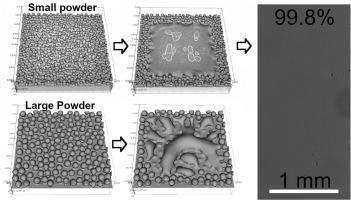Additive Manufacturing ( IF 10.3 ) Pub Date : 2021-07-29 , DOI: 10.1016/j.addma.2021.102186 John D. Roehling 1 , Saad A. Khairallah 1 , Yiyu Shen 2 , Andrew Bayramian 2 , Charles D. Boley 1 , Alexander M. Rubenchik 1 , James DeMuth 2 , Ning Duanmu 2 , Manyalibo J. Matthews 1

|
The build rate of powder bed additive manufacturing could be significantly accelerated if consolidation of metal powders evolved from a serial process to a parallel process. In this work, the physics of Large-Area pulsed laser Powder Bed Fusion (LAPBF) in 316 L stainless steel was studied through high speed imaging and high-fidelity physics simulations. Laser pulses were found to rapidly melt the metal powder, with subsequent fast coalescence of the melted particles into larger droplets. Conduction of heat from the molten droplets melted the substrate surface, and the molten droplets then spread out over roughly 100 μs. For the laser and metal powder parameters used in this study, layer thicknesses of greater than 40 μm resulted in uneven distribution of added material onto the substrate surface and thus an increase in porosity in multilayer prints. Simulations showed that pit features could be created (that can result in pores) from overlying powder particles shadowing the underlying substrate and blocking sufficient laser energy to deposit into the substrate. Simulations suggested that for these laser and powder parameters using thinner layers would reduce shadowing and allow the laser pulse to effectively heat the substrate thereby mitigating the defect formation. Implementing this change ultimately demonstrated >99.5% density in the simulation, and >99.8% density experimentally in 316 L stainless steel prints. During this LABPF process very little material ejection was observed, a known impediment to laser powder bed fusion scaling to larger volume part production. This absence of ejecta suggests that LAPBF may be able to produce material with high quality, suitable for critical applications, and scalable to high volume production.
中文翻译:

大面积脉冲激光粉末床聚变物理
如果金属粉末的固结从串行过程演变为并行过程,则粉末床增材制造的构建速度可能会显着加快。在这项工作中,大面积脉冲激光粉末床聚变(LAPBF)的物理学在 316 通过高速成像和高保真物理模拟对 L 不锈钢进行了研究。发现激光脉冲可以快速熔化金属粉末,随后熔化的颗粒快速聚结成更大的液滴。来自熔滴的热传导使基板表面熔化,然后熔滴散布约 100 微秒。对于本研究中使用的激光和金属粉末参数,大于 40 μm 的层厚度会导致添加材料在基材表面上的分布不均匀,从而增加多层印刷中的孔隙率。模拟表明,可以通过覆盖在下方基材上的覆盖粉末颗粒并阻止足够的激光能量沉积到基材中来产生凹坑特征(这可能导致孔隙)。模拟表明,对于这些激光和粉末参数,使用较薄的层将减少阴影并允许激光脉冲有效地加热基板,从而减少缺陷的形成。实施此更改最终在模拟中证明了 >99.5% 的密度,在 316 中通过实验证明了 >99.8% 的密度 L 不锈钢印花。在这个 LABPF 过程中,观察到的材料喷射非常少,这是一个已知的阻碍激光粉末床融合扩展到更大批量零件生产的障碍。这种喷射物的缺失表明 LAPBF 可能能够生产高质量的材料,适用于关键应用,并可扩展到大批量生产。











































 京公网安备 11010802027423号
京公网安备 11010802027423号